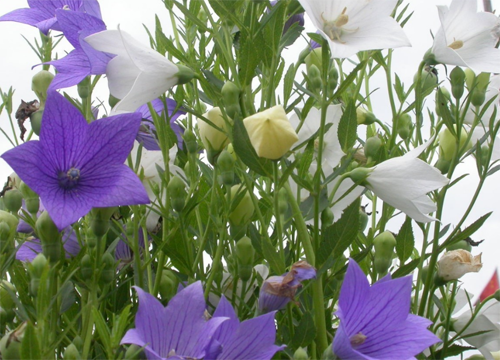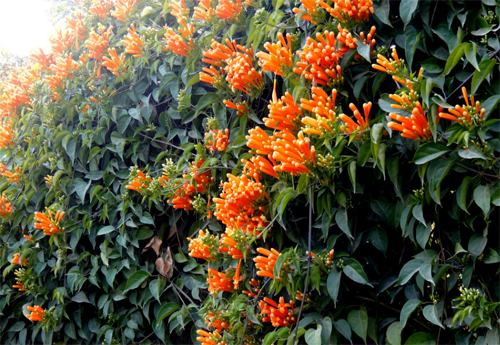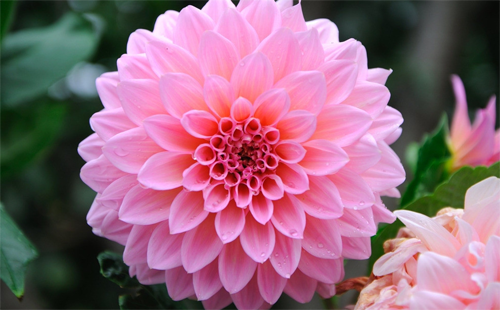The seed planting method of Platycodon grandiflorum
Platycodon grandiflorum is a kind of flower that many people like, and the feeling of this flower is also a touch of sadness. Anyone who has seen Invyasha knows that what is the method of planting Platycodon grandiflorum seeds? How to do a good job in pest control:

Platycodon grandiflorum seed planting method:
1. Seed propagation (growth period 2 years)
Live broadcast is generally used in production. Platycodon grandiflorum seeds are small, the 1000-seed weight is about 1.5g, and the germination rate is about 85%. Under the condition of 18: 25 ℃ and sufficient humidity, Platycodon grandiflorum seeds emerge 10-15 days after sowing.
Winter sowing or spring sowing: winter sowing from November to January of the following year, spring sowing from March to April.
It is better to sow in winter, generally using sowing. When sowing, the seeds were mixed well with tidal fine sand (1 pot of soil mixed with 0.3kg seeds) and sprinkled on the border surface, swept gently with a broom, in order to see the seeds, slightly shock pressure. The following spring, the seedlings emerged early. In spring sowing, in order to make the seedlings emerge neatly, the seeds must be treated or soaked with cover grass after sowing (treatment method: soak the seeds in 30 ℃ warm water, soak them out for 8 hours, wrap them in a wet cloth, put them in a place of 25: 30 ℃, cover them with wet hemp slices, accelerate germination, and rinse and filter with warm water once a day. It takes about 5 days for the seeds to germinate and sow.
The sowing method is the same as that of winter sowing, keep the soil moist for a long time, and generally emerge in about 15 days. The seed consumption per mu is 3~4kg.
2. Seedling transplanting: the growing period is 1 year.
Platycodon grandiflorum seedlings can be transplanted from April to June, too early, because the small size of Platycodon grandiflorum seedlings affects the quality of seedlings, too late seedlings greatly affect transplanting.
Specific methods:
Choose land neither in high slopes nor in low-lying places, it is best to choose a good drainage environment, turn more than 30 cm deep, make a good pit, in order to facilitate sprinkler irrigation water during drought, and then mix Platycodon grandiflorum seeds with fine soil for uniform sowing, shock pressure above, cover weeds, keep the soil moist, generally 10-12 days after seedlings, choose rainy days to remove mulch, in order to facilitate seedling growth.
3. Transplanting:
The growth period is 1 year. One-year-old Platycodon grandiflorum seedlings were selected before sprouting from autumn and winter of that year to spring of the following year, and were graded and planted respectively. When planting, the trench of 25cm was opened according to the row spacing 19cm, and then the Platycodon grandiflorum seedlings were obliquely inserted into the ditch at an angle of 75 °. According to the plant spacing 6~8cm, the soil cover should be slightly higher than the seedling 3cm.
(1) weeding after intermediate ploughing and emergence of Platycodon grandiflorum seedlings.
When the seedling has 4 leaves, the seedlings are weakened, and when the leaves are 6 or 8, the seedlings are fixed according to the plant spacing of 1 to 2 inches, and the soil is loosened when dry and wet is suitable, so that the soil is often loose and there are no weeds in the field.
(2) drainage
Platycodon grandiflorum has high planting density and is afraid of stagnant water. Therefore, in the hot and humid plum rain season, we should timely dredge ditches and drainage to prevent stagnant water from rotting roots.
(3) picking flowers
The flowering period of Platycodon grandiflorum is as long as 4 months. Flowering consumes a lot of nutrients and is easy to sprout lateral branches. Therefore, flower picking is an important measure to increase the yield of Platycodon grandiflorum.
Control methods of Platycodon grandiflorum flower diseases and pests:
1. Root rot
Damage to the roots, black and brown spots appeared in the damaged roots, and rotted until the whole plant died in the later stage.
Prevention and control methods:
The main results were as follows: (1) 1000 times of carbendazim was used to irrigate the disease area.
(2) pay attention to drainage after rain, and the field should not be too wet.
2. Powdery mildew
The main damage to leaves. At the time of onset, the diseased leaves were covered with ash powder, which was so serious that the whole plant withered.
Prevention and treatment: at the beginning of the disease, it was sprayed with Baume 0.3 degree stone sulfur mixture or Baifenjing liquid or 1800 times solution of 20% trimethoprim powder.
Other considerations:
During the growing period of Platycodon grandiflorum, it is found that other pests can be controlled by conventional methods, but the use of pesticides is prohibited 20 days before harvest.
Platycodon grandiflorum flower alias:
Platycodon grandiflorum flower, also known as monk crown hat, Baoguanhua, originated in China, it is Platycodon grandiflorum family Platycodon grandiflorum perennial root herbs. There are many varieties, including pure white, red and purple, striped ones, semidouble, large flowers, and early flowers. Among them, the white flower is still fragrant, and the Korean people like to eat it as a wild vegetable.
This is the end of the seed planting method of Platycodon grandiflorum flowers. We should pay attention to the changes of Platycodon grandiflorum flowers in the process of cultivation and timely control of diseases and insect pests.
What are the planting methods and precautions of Platycodon grandiflorum?
Platycodon grandiflorum belongs to herbaceous plants, its flowers are relatively bright and beautiful, the flowers are lobed triangular, or narrow triangular, and Platycodon grandiflorum has medicinal value, so there are more people to plant, and the planting of Platycodon grandiflorum is relatively simple. Today, the editor will share with you how to fertilize Platycodon grandiflorum. What fertilizer?
How to raise Platycodon grandiflorum flowers:
Platycodon grandiflorum flowers grow well in humus soil or sandy soil with deep soil layer, loose and fertile soil and good drainage. Live broadcast is generally used in production. The seeds of Platycodon grandiflorum were small and emerged 10-15 days after sowing under the condition of 18-25 ℃ and sufficient humidity.
Points for attention in Platycodon grandiflorum flower culture:
First, Platycodon grandiflorum like cool and moist, like light, cold, so we should pay attention to, Platycodon grandiflorum flower watering do not rush water, Platycodon grandiflorum flower is afraid of stagnant water, soil water is easy to cause root rot.
Second, Platycodon grandiflorum flowers like fertile land. Pay attention to fertilizing Platycodon grandiflorum flowers in the process of growth.
Third, Platycodon grandiflorum flower culture should pay special attention to the prevention and control of diseases and insect pests, so as not to harm the growth of Platycodon grandiflorum flowers.
Platycodon grandiflorum culture methods and points for attention to share with you here, I believe we all have a certain understanding, I hope this article is helpful to you, I wish you good luck.
Platycodon grandiflorum field management and pest control 1 planting techniques 1.1 soil preparation Platycodon grandiflorum for deep-root plants, should choose soil layer is deep, loose and fertile, well drained humic soil or sandy soil is good, after selecting the site, every 667m ²apply compost 2500 kg, add 20 kg calcium superphosphate, scattered into the ground, turn over 30 cm deep, level Harrow fine. 1.2 timely sowing Platycodon grandiflorum mainly with seed culture, spring sowing, autumn sowing or winter sowing, 667 m ²with seed 2 kg. It can also raise seedlings and transplant, because the yield of direct seeding is higher than that of transplanting, and the root is less straight, so it is easy to scrape, process, good quality and multi-use in production. Attention should be paid to the cultivation of seeds newly produced in the same year, the new seeds germinate quickly, the germination rate is high, and the seedlings are uniform, robust and beneficial to management. the germination rate of the old seeds in the next year is low or even can not germinate. In order to improve the germination rate of the seeds, the seeds can be treated first, soaking the seeds in warm water for 12 hours before sowing, mixing well with appropriate amount of wet sand, stacking for a few days, and then sowing can obviously increase the germination rate. The strip sowing method is used to trench the whole border surface according to the row spacing of 18-21 cm, the depth is about 2 cm, and the cover soil is 1 cm after sowing, or the more advanced wide strip sowing method is adopted, that is, the width of the trench is 10 cm, the row spacing is unchanged, and the soil is covered after sowing. Wide strip broadcasting has many advantages, such as simple management, good quality of finished products and so on. The temperature is suitable and the seedlings can emerge in about 15 days. (2) Field management 2.1 reasonable close planting row spacing is 17-20 cm, plant spacing is 3-5 cm. If the plant is too dense, the growth of the plant is weak and it is vulnerable to diseases and insect pests. Too thin, low yield. If the seedlings are suitable for wide strip sowing, the seedlings are not crowded, and there is no need to remove too many seedlings. Proper close planting is the key to increase production. 2.2 Platycodon grandiflorum grows slowly in the early stage of ploughing and weeding, and it is easy to breed miscellaneous humility, so it should be pulled out in time to prevent the spread of grass famine. The planting site should be watered thoroughly first, and when it is dry and wet, the soil should be loosened once, so as not to dry and crack the ground and cause dead seedlings. Mid-ploughing should be carried out when the soil moisture is moderate. After the plants grow up and close the ridges, they no longer need to carry out intermediate ploughing and weeding. 2.3 it is necessary to topdressing thin human feces and urine for 1-2 times at seedling stage to promote seedling growth. At the end of June, more fertilizer was applied at flowering stage, mainly phosphorus and potassium fertilizer, to prevent the growth from being affected by excessive nutrient consumption due to flowering and fruiting. After entering winter, it is necessary to re-apply overwintering fertilizer, combined with fertilization to cultivate the soil. When the plant height is about 1 meter in the next spring, properly control the amount of nitrogen fertilizer, combined with topdressing phosphorus and potassium fertilizer, make the stem grow sturdy, can prevent or reduce lodging. 2.4 the flowering period of Platycodon grandiflorum is longer, which consumes a lot of nutrients and affects the root growth. In addition to staying in the field, thinning flowers and fruits can improve the yield and quality of roots, and buds can be removed manually, such as cutting buds with a sickle. Or paclobutrazol, sprayed in full bloom, can prevent flowering. 2.5 drained Platycodon grandiflorum has a high planting density. When it is hot and humid in summer, it should be drained in time to prevent stagnant water and rot roots, resulting in reduced production. 3. Main diseases and insect pests 3.1 Root rot 3.1.1 the symptom is a root disease caused by Fusarium oxysporum. During the disease period from June to August, the local roots were yellowish brown and rotten at the beginning, and then gradually expanded. When the disease was serious, the aboveground part withered and died 3.1.2. Control method A, pay attention to crop rotation, timely elimination of stagnant water, planting in low-lying land or rainy areas, high beds should be made. B, when preparing the soil, apply more basic fertilizer to improve the soil and enhance the disease resistance of the plants. 50100kg lime powder is applied every 667m ²to reduce the harm, or 5kg carbendazim is used to disinfect the soil every 667m ², and the disease can be controlled by pouring 1000 times the solution of 50% topiramate. C, remove the diseased plant in time. 3.2 the symptom of purple stripe plume 3.2.1 is caused by a basidiomycete in fungi. Damage to the root, first from the fibrous root, and then extended to the main root; the disease is yellow-white at the beginning, you can see the white fungus, and then become purple-brown, the root rot from outside to inside, the appearance of the cord interweaves into a mycelial membrane, when broken out of the slag. The diseased plant on the ground gradually yellowed and withered from bottom to top, and finally died. 3.2.2 Control methods and methods of the same root rot. 4. Harvest processing 4.1 the harvest years of Platycodon grandiflorum are different due to different regions and sowing dates. Generally, it is harvested in the same year, or in the second year, but slightly earlier in the Northeast. The harvest time can be carried out from the end of September in autumn to the middle of October or before the sprouting of Platycodon grandiflorum in the following spring. The autumn collector's weight is solid and the quality is better. Generally, when the aboveground stems and leaves wither, the roots have not been enriched too early, and the drying rate is low, which affects the yield; it is not easy to peel too late. When starting to dig, prevent the main root from being broken. 4.2 after digging out the fresh roots, remove the soil and Reed head, scrape off the cork with bamboo knives, wood edges, porcelain pieces, etc., wash, dry or dry. The skin should be scraped while it is fresh. If it takes a long time, the root skin will be hard to shave. It should be dried in time after shaving. Platycodon grandiflorum takes back too much processing, it can be buried with sand to prevent the skin from drying and shrinking, so it can be easily peeled. The drying rate is 30%. The quality of Platycodon grandiflorum is better when the root is enlarged, white or slightly yellowish, solid and with chrysanthemum pattern. .
- Prev

The planting method of firecracker flower and the difference between propagation and Lingxiao flower
Firecrackers blossom that is a string of firecrackers, like firecrackers, arranged firecrackers, so there is the title of firecrackers, what is the planting method of firecrackers? How do you reproduce? What is the difference between Lingxiaohua and Lingxiaohua? Firecracker flower planting method: pot soil and flowerpot selection
- Next

When will the root planting method of Dahlia be planted?
The flowers of Dahlia are big flowers, they are very beautiful, and people like them very much. Dahlia is usually planted with root. Let's take a look at the method of planting Dahlia with root.
Related
- Fuxing push coffee new agricultural production and marketing class: lack of small-scale processing plants
- Jujube rice field leisure farm deep ploughing Yilan for five years to create a space for organic food and play
- Nongyu Farm-A trial of organic papaya for brave women with advanced technology
- Four points for attention in the prevention and control of diseases and insect pests of edible fungi
- How to add nutrient solution to Edible Fungi
- Is there any good way to control edible fungus mites?
- Open Inoculation Technology of Edible Fungi
- Is there any clever way to use fertilizer for edible fungus in winter?
- What agents are used to kill the pathogens of edible fungi in the mushroom shed?
- Rapid drying of Edible Fungi

